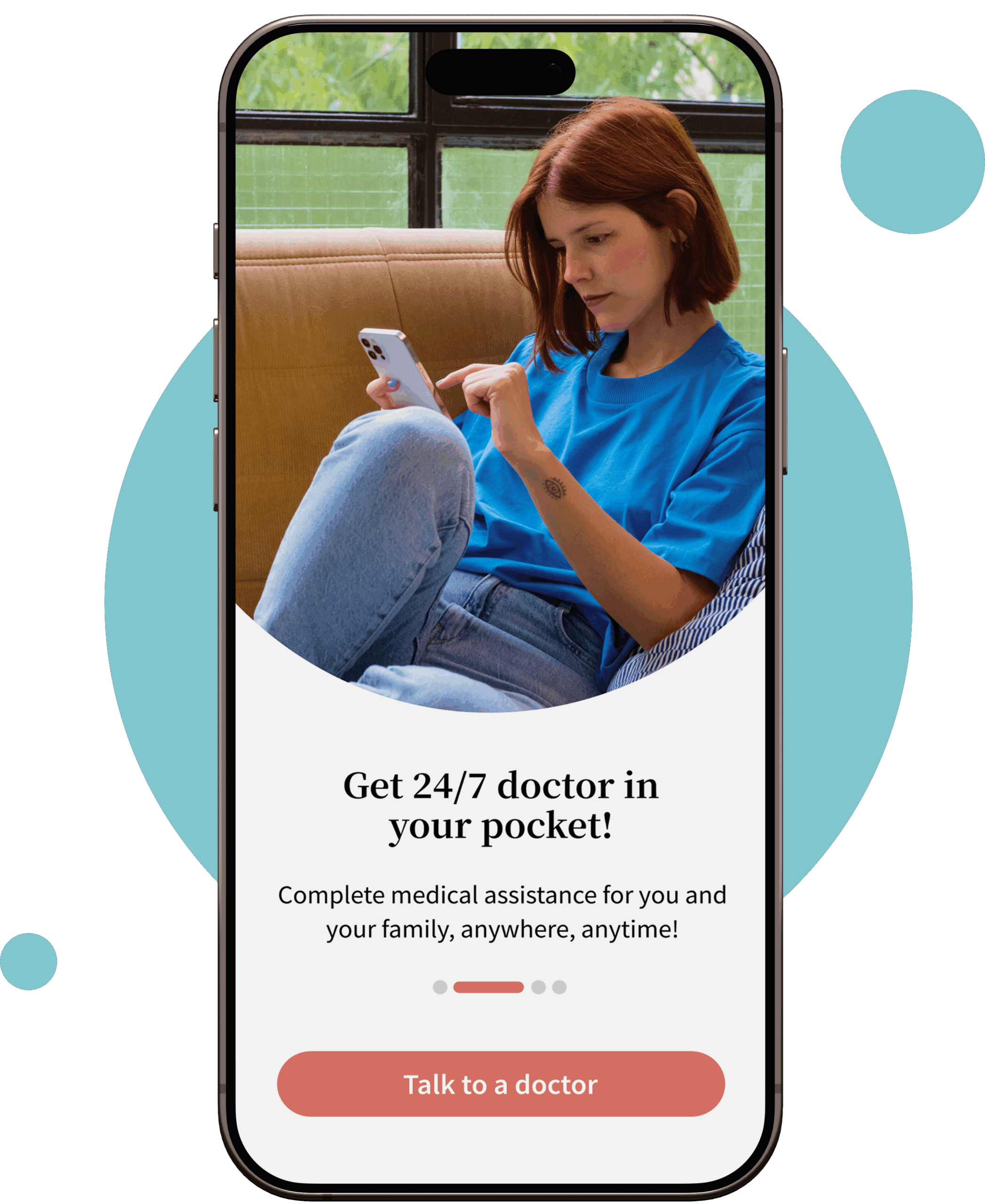
Sinusitis treatment online and prescription
Common treatments for sinus infections include bacterial antibiotics (usually for 3–28 days), pain relievers, nasal corticosteroids, and decongestants. When the condition gets worse, endoscopic sinus surgery could be an option.
You can contact our board-certified physicians immediately if you are suffering from acute sinusitis symptoms and need a prescription for a sinus infection. Their approval time is minimal.
How to connect with doctor for sinusitis?
Connect with a health care professional online in 3 easy steps.
1
Describe your issue
Download our app, register and tell us about your medical issue to get started.
- Cold/flu
- STD
- UTI
- Sexual Health
- Skin
- Covid
2
Chat with a doctor
Connect with a board-certified doctor. You can chat, send pictures and videos.
Hi I’m Dr. Nicole. How may I help you?
3
Get online prescription
Our online doctors can help you with your medical issues and give you prescriptions.
Prescription
- Azithromycin 250mg, two tablets on day 1 and then one tablet for 4 days.
- Benzydamine HCl Gargles 0.15% solution.
Send Prescription
How is sinusitis treated?
Sinusitis can often resolve on its own, but for persistent or recurrent cases, various treatments are available, tailored to the underlying cause and duration of the condition.
Initial approaches
- For many, over-the-counter (OTC) solutions provide sufficient relief.
- Painkillers like ibuprofen or acetaminophen are commonly used to ease discomfort.
- Decongestants, whether as nasal sprays or pills, reduce mucus buildup, but nasal sprays should be limited to a 3-day use to prevent worsening congestion.
- Additionally, a bioelectronic sinus device, available OTC, can alleviate inflammation, pain, and congestion through microcurrent stimulation of sinus nerve fibers.
Targeted treatments
In cases where sinusitis is linked to allergies, identifying and managing these triggers is crucial.
- Antihistamines and allergy avoidance strategies are effective, and long-term relief can be achieved with allergy shots, which gradually desensitize the immune response.
Prescription medications
- When sinusitis is suspected to be bacterial, antibiotics may be prescribed.
- A 10-14 day course is typically sufficient for acute sinusitis, whereas chronic cases might require prolonged use. However, antibiotics are ineffective against viral infections.
- For severe or chronic sinusitis, inhaled steroids might be recommended to reduce sinus membrane swelling, with oral steroids as an option for more stubborn cases.
Online consultations can streamline access to treatments. An online doctor can evaluate your symptoms and prescribe antibiotics or other necessary medications. Telehealth services facilitate convenient and timely management of sinusitis, ensuring you receive appropriate care without needing to visit a clinic in person.
Best antibiotics for sinus
If a secondary bacterial infection develops, antibiotics are required to treat serious sinus infection. Here are some commonly prescribed antibiotics for bacterial sinusitis:
1. Amoxicillin-Clavulanate (Augmentin)
This combination antibiotic is often the first choice for bacterial sinusitis. Amoxicillin works by stopping the growth of bacteria, while clavulanate helps prevent bacteria from becoming resistant to amoxicillin.
Typically prescribed for 10-14 days for acute infections. For chronic or severe cases, the duration may be longer.
Considerations: It’s generally well-tolerated, but potential side effects include gastrointestinal issues such as diarrhea and nausea.
2. Doxycycline
An alternative for patients with a severe allergy to penicillin-type drugs, doxycycline is a broad-spectrum antibiotic that inhibits bacterial protein synthesis. Suitable for those who cannot take amoxicillin-clavulanate. The usual course is 7-14 days, depending on the severity of the infection.
Considerations: Common side effects include sun sensitivity and gastrointestinal discomfort. It should not be used in children under 8 years old or pregnant women.
3. Cefdinir
A cephalosporin antibiotic, cefdinir is another alternative for treating bacterial sinus infections, especially for those who may not tolerate other antibiotics. Generally prescribed for 5-7 days for acute infections.
Considerations: Side effects can include diarrhea and rash. As with all antibiotics, it’s essential to complete the full course even if symptoms improve early.
Important note on Fluoroquinolones:
Examples: Ciprofloxacin (Cipro) and Levofloxacin (Levaquin)
Warnings: The FDA has issued warnings about the use of fluoroquinolones due to potential severe side effects like joint pain and tendonitis. These should be avoided for less serious infections and used only when absolutely necessary and prescribed by a physician.
Antibiotic treatment for sinusitis should always be guided by your healthcare provider to ensure the correct medication and dosage are used based on individual health needs and medical history.

What are the side effects of taking medicine for sinusitis?
Medications for sinusitis, including antibiotics and other treatments, can cause a variety of side effects. It’s important to be aware of these potential reactions and to consult your doctor if they persist or worsen. Some common side effects include:
- Dry mouth or nose or throat
- Blurred vision
- Upset stomach
- Nervousness
- Drowsiness
- Dizziness
- Nausea
Sinusitis medication we prescribe
Antibiotic
Learn MoreAntibiotic
Learn MoreAntibiotic
Learn MoreFAQS about sinusitis treatment online
Yes, when symptoms indicate a bacterial sinus infection, online providers can prescribe antibiotics. They can also recommend over-the-counter treatments for allergies or viral infections.
What doctors prescribe for sinus infections?
For sinus infections, your doctor will prescribe you antibiotics in case of bacterial infection or antihistamines and avoid the trigger in case of an allergic reaction. For infection, the recommended medication is amoxicillin-clavulanate (Augmentin). If you have a penicillin allergy, your doctor may prescribe doxycycline as an alternative.
Can I get over-the-counter antibiotics for a sinus infection?
No, antibiotics require a prescription. Over-the-counter medicines can help with symptoms, but antibiotics are only effective if the sinusitis is bacterial.
Do sinus infections go away on their own?
Sinus infections often resolve without treatment. However, in rare cases, untreated sinus infections can lead to serious complications if bacteria or fungi spread to areas such as the brain, eyes, or nearby bones. Monitoring symptoms and seeking medical advice if they persist or worsen is important.
When to see a doctor for sinusitis?
If you have a persistent headache or fever or if your symptoms have not subsided within 10-14 days, you should contact your doctor as your issue seem serious. It might be because of acute sinusitis or allergic sinusitis infection and treated with relevant medicines upon consultation. In rare cases, the infection may develop into chronic sinusitis.
Why won't my sinus infection go away?
If you have a persistent sinus infection, chances are your acute infection has turned into chronic over time. It can be due to either an allergic reaction to something that has inflamed your sinuses or due to infection. See a doctor for proper diagnosis and treatment.
What is the fastest antibiotic for a sinus infection?
Amoxicillin (Amoxil) or amoxicillin-clavulanate (Augmentin) are commonly recommended for those not allergic to penicillin as the first line of action.
How do you know if your sinus infection is getting worse?
Excessive pain in the eyes, ears, head, or throat, or symptoms like inability to open eyes or dizziness, are signs of a severe sinus infection.
How long do antibiotics for sinus infections take to work?
Many people start feeling better 3 to 4 days after beginning antibiotics for bacterial sinusitis. Antibiotics do not work for viral infections.
How do I know if I need antibiotics for a sinus infection?
Antibiotics may be needed if symptoms persist for more than 10 days without improvement or if symptoms initially improve but then worsen.
Can a telehealth doctor diagnose a sinus infection?
Yes, telehealth doctors can diagnose a sinus infection, recommend treatments, and prescribe medications if needed.
When do you know if your sinus infection is getting better?
Acute sinusitis symptoms typically resolve within a week to 10 days. If symptoms persist for 12 weeks or more, it may be chronic sinusitis.
How long can sinusitis last?
Sinusitis normally goes away in 10 days in case of acute infection or allergy. However, chronic sinusitis takes around 2-8 weeks for complete recovery.
How do I know if my sinus infection is viral or bacterial?
If the sinus infection is due to a virus, it will clear up in 5-7 days. However, it may take more than ten days to complete recovery in the case of bacterial infection.
Get started today
Talk to online doctors now and get medical advice, online prescriptions, and referrals within minutes. On-demand healthcare services at your fingertips.



